The FA Cup final is always a special occasion, but this year’s edition promises to be an even more thrilling clash as Man City and Man United face each other in the final for the first time in the tournament’s history.
The two rivals from the same city will battle it out at Wembley Stadium on 3rd June, with both teams aiming to lift the oldest and most prestigious trophy in English football. Manchester City has won the Premier League for the third consecutive time and fifth in the last six years. They are now chasing a historic treble. They have qualified for the UEFA Champions League final in Istanbul, but before that, they want to secure the double in the domestic competitions. Pep Guardiola’s side has been dominant in English competitions, scoring 94 goals and conceding only 33 in 38 league games.
On the other hand, Erik ten Hag has managed to change United’s mentality. After Sir Alex Ferguson’s era, with a short break during José Mourinho’s period, the Red Devils can be considered one of the biggest names in England once again. After beating Chelsea on 25th May, they returned to the CL after a one-year absence, and of course, their biggest success for this season up until this point is the win of the Carabao Cup.
So, this is more than a derby. This is about their pride and who is the boss of the town. This tactical analysis will preview the tactics that can be expected from both sides.
Head-to-head
Manchester City and Manchester United have met 189 times in all competitions, with United winning 78 times, City winning 58 times, while there have been 53 draws. However, City has had to manage to balance, winning nine of the last 18 meetings since Pep Guardiola took charge in 2016.
The two teams have met nine times in the FA Cup, with United winning six times and City winning three. The last time they met in the competition was in the third round in 2012, when United won 3-2 thanks to two goals from Wayne Rooney and one from Danny Welbeck.
This year, Manchester City has managed to lead in almost all the categories that matter, including goals, goals conceded, expected goals, possession, passes, and more. The chart shows the comparison between the two finalists. Manchester City is better than United in all categories, except for recoveries per 90. Of course, City could not rank higher for this specific metric, as the team has the ball for most of the playing time.
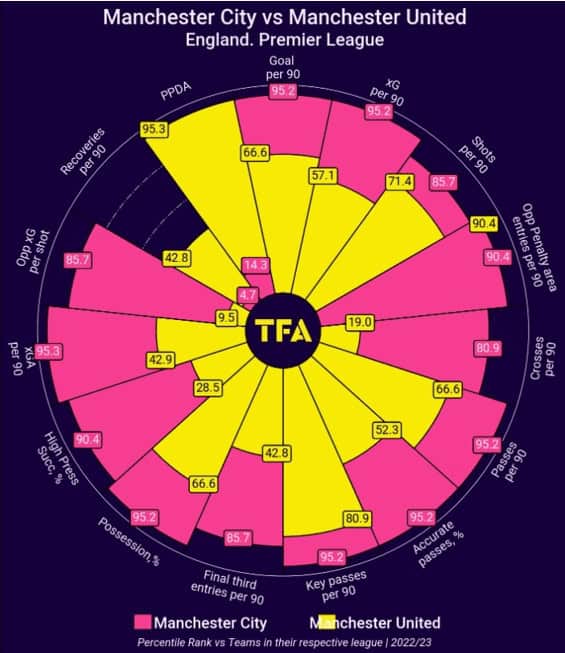
Their last game on 14th January was a tactical masterclass by Erik ten Hag. The 2-1 win showcased his tactical intelligence as his team executed a well-designed strategy, preventing City’s players from playing their game.
One of Manchester City’s greatest strengths is overloading the centre of the pitch with three midfielders, inverted full-backs, inverted wingers, and recently, John Stones as a false centre-back. Additionally, their ability to progress the ball forward from the back, utilising the centre-backs, is another key point. Guardiola aims to build the team’s positional attacks based on these principles. However, Erik ten Hag’s strategic plan for that specific match was to disrupt these functions.
First, United’s players attempted to deny any space for the centre-backs to advance with the ball or find easy vertical passes. They formed a compact mid-block with narrow width, leaving João Cancelo and Kyle Walker, the full-backs, with plenty of space. Manchester United’s wingers aimed to press City’s centre-backs with curved runs, blocking the passing lanes to the full-backs and forcing them to play towards the centre where defensive density was higher.
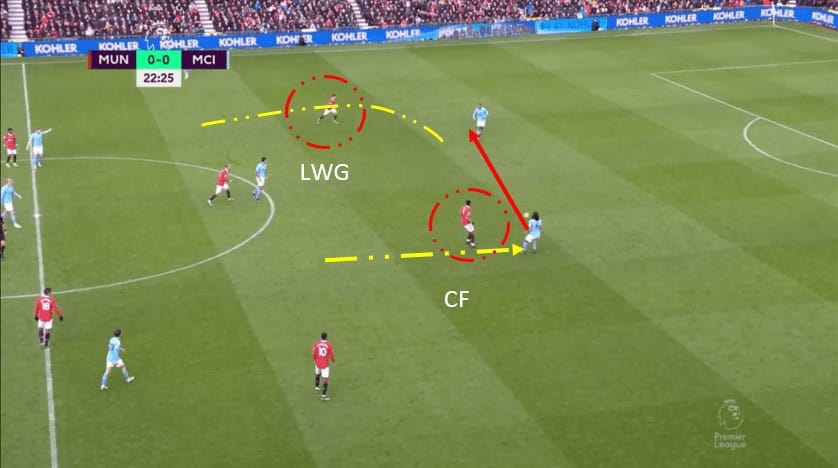
Ten Hag designed a man-marking approach for the game to prevent being overwhelmed in the centre of the pitch, where City demonstrates its greatest strength. Fred was tracking Kevin De Bruyne, Christian Eriksen was determined to keep Rodri away from the ball, and Casemiro was attempting to stop Bernardo Silva. The defenders were tasked with tracking Erling Haaland when he opted to drop back and receive the ball. The man-to-man strategy was mainly employed in the central axis.
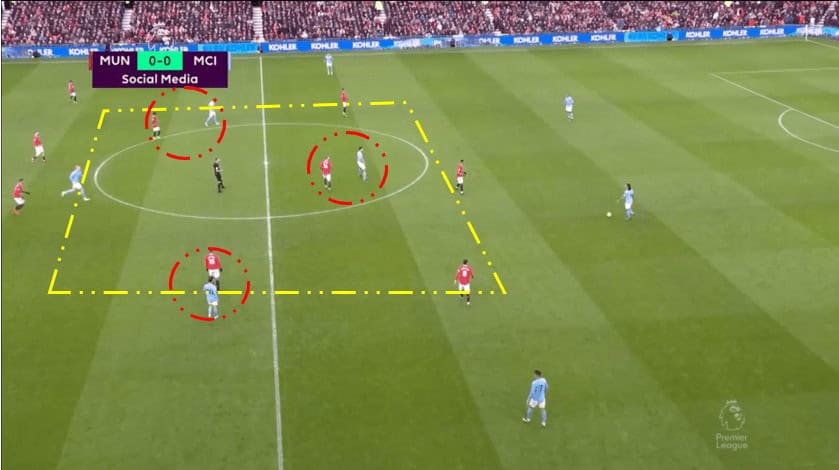
Haaland was compelled to drop back excessively to engage in the game, which aided United in keeping him away from goal-scoring areas. The particular game proved to be one of his poorest performances in terms of posing a threat to David de Gea. He managed a mere 0.08 xG with two off-target shots and only three touches in the penalty area in contrast to his average of 5.74.
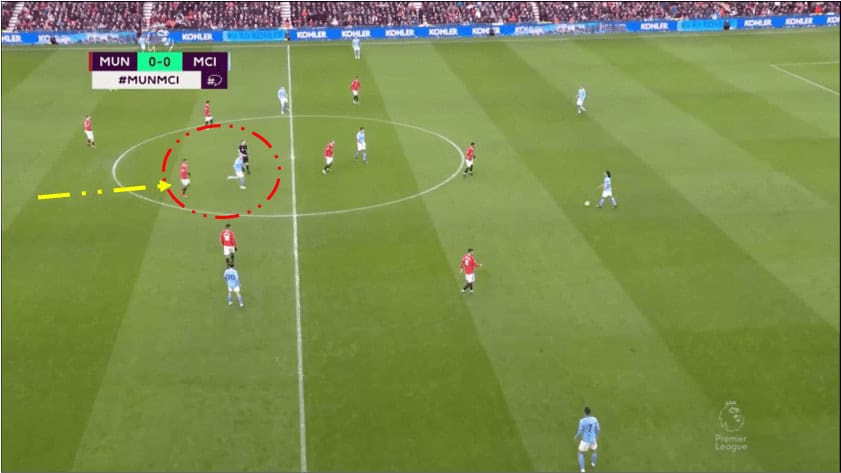
The specific match was generally bad for Manchester City in terms of efficiency in the attacking phase, with only 0.43 xG compared to their average of 2.17 in the Premier League. Additionally, City struggled to create opportunities in their preferred way of keeping the ball. They had 25 positional attacks and three shots, compared to their league average of 33.62 and 8.3 respectively. Due to Manchester United’s defensive density in the middle, City had a high number of lost balls (105) compared to their usual average (85.89).
Manchester City
Manchester City’s results in the last six games in all competitions are three wins, two draws, and one loss, with 10 goals scored and three conceded. Naturally, the last two unsuccessful results occurred after City secured the Premier League title, and Guardiola initiated an extensive rotation in preparation for the two upcoming finals.
Possible line-up
Unfortunately for fans who wish to see a great final, City has been hit by a string of injuries. Stones and Phil Foden are the latest additions to the injury list, having picked up knocks in the game against Brighton. Before that, five players were already forced to miss the trip to Brighton due to injuries. Before the Brighton match, Guardiola revealed that several players got injured while celebrating their Premier League title victory on Sunday. He stated, “They are not in good shape. I’m unsure of what happened. Many players got injured after winning the Premier League on Sunday. Three, four, and five of them are unfit. [Aymeric] Laporte, [Manuel] Akanji, [Rúben] Dias, and [Jack] Grealish are unavailable. We’ll observe their recovery in the coming days.”
This growing list of absentees includes Dias, Laporte, Akanji and Grealish, who weren’t even part of the squad for the Brighton game. Adding to their hardships, Nathan Aké is still struggling with a hamstring problem. Also, De Bruyne is added to City’s medical report. Due to the lack of available centre-back options, City had to make do with playing Walker and Rodri as makeshift centre-backs in the second half against Brighton.
Throughout the season, Guardiola has employed various formations, but two of his core strategies have been the 4-3-3 and 4-2-3-1 formations.
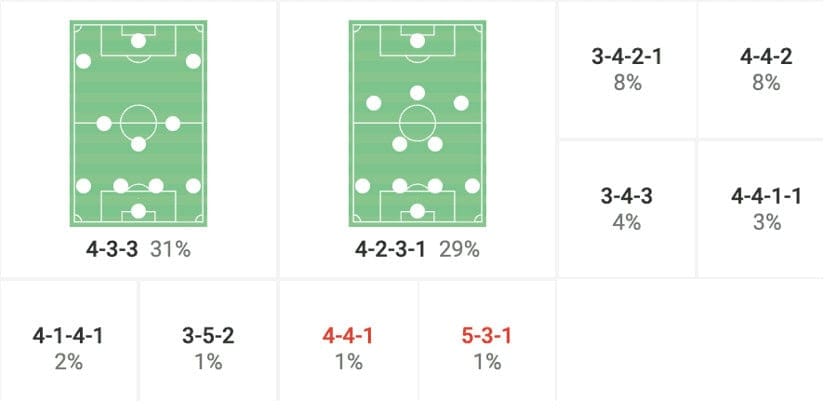
Against Real Madrid, Guardiola fielded his strongest starting eleven of the season. Ederson guarded the goal, while Akanji, Dias, Stones, and Walker formed a versatile defensive backline. The midfield trio consisted of Rodri, De Bruyne, and İlkay Gündoğan. Up front, Grealish and Bernardo Silva occupied the wings, with Haaland playing as the central forward.
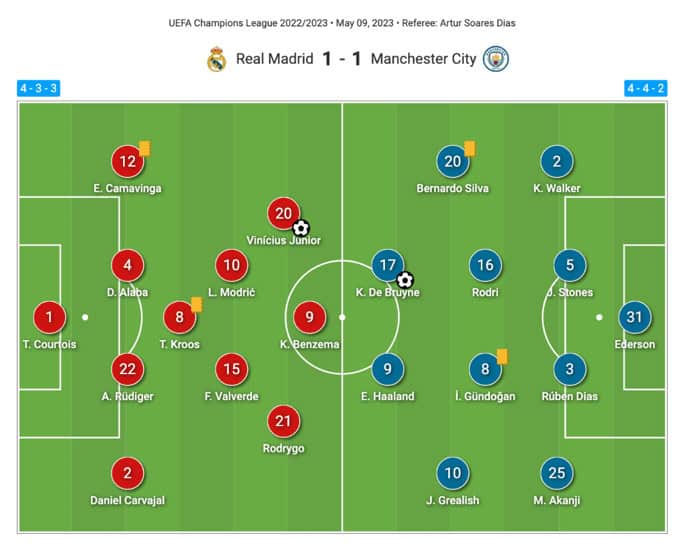
Of course, the above can be different if De Bruyne, Dias, Grealish, and Akanji are not fully fit. Ahead of the Champions League final, Guardiola would probably want to avoid putting players who are not 100% fit in danger. So, the safest discussion about the possible line-up would be to mention the available players for each position.
Ederson will be in goal. As for the defence, Guardiola currently has Laporte while Rodri and Walker can cover the other centre-back position. Even if this scenario is unlikely to occur, realistically speaking, all the other centre-backs are currently considered injured. For full-back positions, Rico Lewis and Sergio Gómez can be used in case Walker is deployed as a centre-back and Akanji is not fit.
In midfield, Rodri, De Bruyne, and Gündoğan are without a doubt the starters in a normal scenario. However, if De Bruyne is ruled out and Rodri is used as a centre-back, then Silva will take his place in the centre, and Kalvin Phillips will most probably start the game.
Up front, Haaland will be the striker. For the wings, and due to City’s absence, Riyad Mahrez will most likely be in the starting eleven, with Foden and Álvarez occupying the other side in case Grealish is out.
City’s strength – overloading the centre of the pitch.
One of Guardiola’s main principles throughout his coaching career has been to overload the centre of the pitch. After the departure of Cancelo during the winter transfer window, the Catalan coach was forced to find an alternative solution to the inverted full-back tactical concept. The use of Grealish and Mahrez removed the option of having wingers occupy the half-spaces and create numerical superiority.
Stones gave the solution by playing as a “false centre-back,” pushing in the middle to create the necessary numerical overload (4 v 3 or 4 v 2), which forces the opponents to narrow their defensive block, leaving spaces on the flanks for the wingers to have lots of 1v1 situations.

In case Stones is not available, Rodri could be his replacement. To gain the advantage of numerical superiority in the centre, Bernardo Silva could be used as a right winger with the instruction to constantly get inside, leaving the wide lane free for Walker to push up. The build-up with three will be again possible with Laporte, Rodri, and one full-back.
Another solution is to use Mahrez as a classic winger and have Walker as an inverted full-back. The challenge with this tactic is that Walker can get inside, offering passing options for switching sides, but he does not have the necessary skills to stay there for long periods and operate as a pivot.
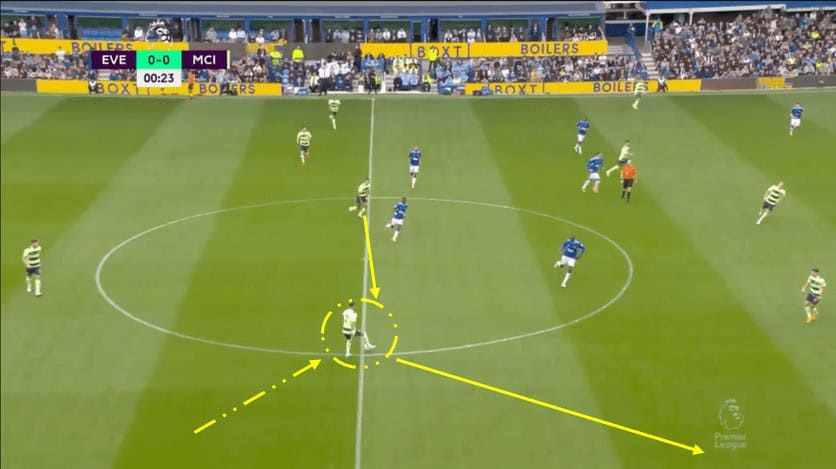
This will provide an additional attacking option of creating a 2v1 on the flanks, helping Mahrez to cut inside and do his favourite type of cross: the in-swinger.
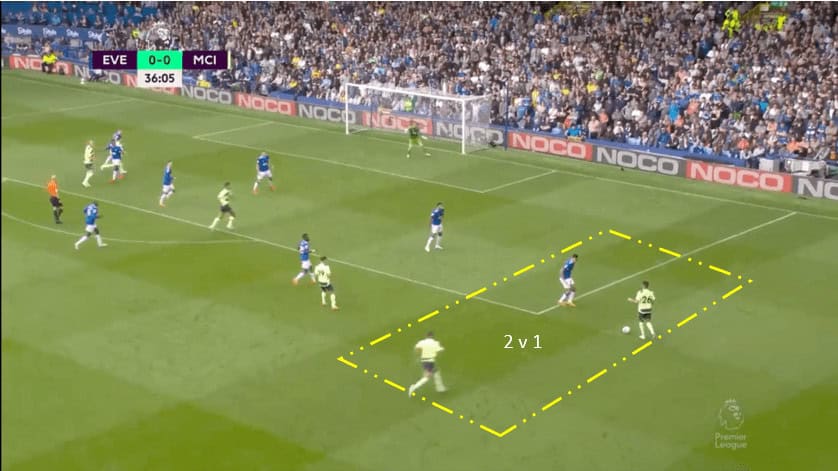
Manchester United
Manchester United’s results in the last six games are four wins and two losses, with nine goals for and four against.
Possible line-up
Manchester United’s major injury concern is Antony, who was stretchered off with an ankle injury against Chelsea last Thursday. He has scored eight goals and assisted three in all competitions this season, forming a lethal partnership with Bruno Fernandes and Marcus Rashford. His absence will be a huge blow to United’s attack. The captain, Harry Maguire, has returned to action after missing several games due to injury too.
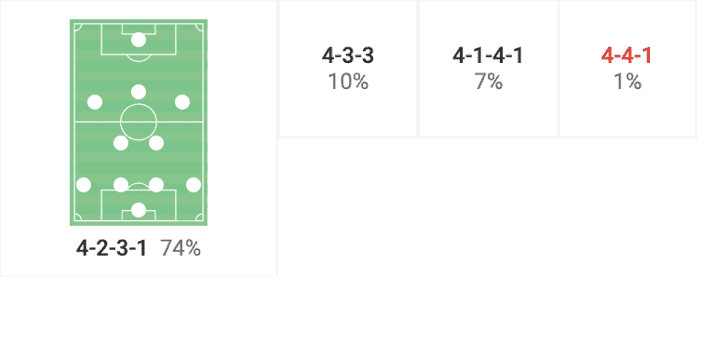
Ten Hag, in contrast to Guardiola, has based his tactics this season mainly on the 4-2-3-1. Up front, Anthony Martial will be the centre-forward, acting as a target man with his ability to receive long balls and find passes to the wingers running behind his back or hold the ball and pass back to midfielders coming for support.
David de Gea will be in goal, and the back line will include Aaron Wan-Bissaka, Raphaël Varane, Maguire, and Luke Shaw on the left side. Victor Lindelöf who had a few good games the last weeks will be in the starting eleven, leaving Maguire out of the line-up. For the midfield, four players will fight for a starting position, with Casemiro, Eriksen, and Fernandes having an advantage against Fred. In case ten Hag wants to strengthen even more the centre of the pitch, Fred, who is the player with the most per 90 duels in the league for United (10.49), will be in the starting lineup, and Fernandes can move to the flanks in the position of Jadon Sancho. Rashford can be considered as a guaranteed starter for the final.
The impact of Casemiro
Casemiro was a significant addition to Manchester United’s squad this season. He ranks fifth on the list of the top players in defensive duels in the league. Except for his defensive skills, this year he also made a huge contribution to United’s attacking phase.
Against City’s biggest strength, which is the presence of many quality players in the middle of the pitch with De Bruyne, Rodri, Gündoğan, and Stones, or an inverted winger trying to progress the ball forward through the thirds, Casemiro can be a decisive factor. A man-oriented approach and the presence of two strong and aggressive defensive midfielders like Fred and Casemiro could be the solution.
In the last five games, he scored twice having 1.31 XG. He had a total of nine shots with 44% accuracy, but his biggest contribution was in the ball distribution. During these games, Casemiro had 271 total passes with 82% accuracy, while at the same time, Fernandes had 245 and Eriksen had 245 too. He tries to always be able to offer near-pass support to the centre-backs and, at the same time, free up the space for them to drive forward with the ball if it’s feasible.
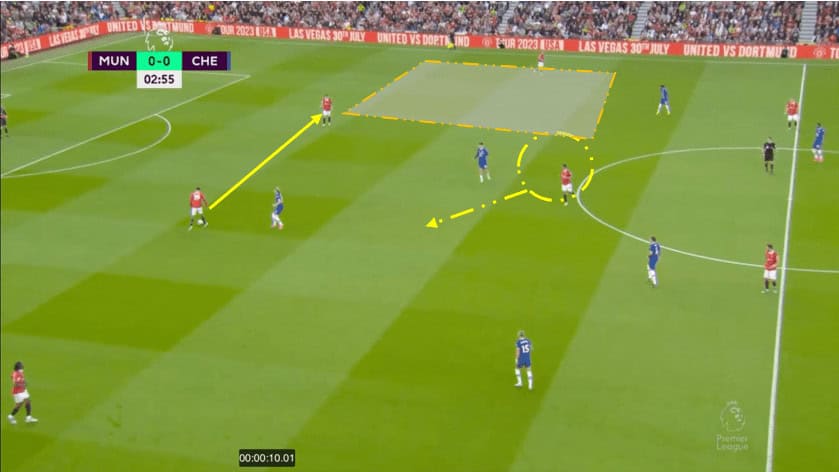
Creating scoring opportunities
Against a team with so much possession during the games, United must have a specific plan on how to attack. Recovering the ball higher up the pitch with a fast forward pass could be one option while the other one is to use Martial as the target man and the fast winger exploiting the spaces behind the back line.
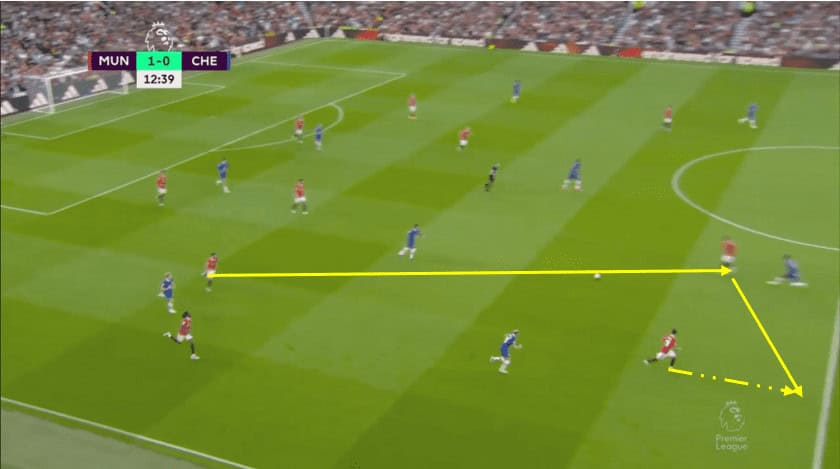
The fast wingers of United may be the key for ten Hag’s team to win the trophy. Against a team that likes to build up in threes, there will be available spaces on the flanks for 1v1 situations and counterattacks. Rashford and Sancho excel in attacking 1v1 situations, but to have them both on the pitch, one of Fred, Eriksen, or Fernandes would need to stay out with Fred, which would be the most possible option.
The transition to attack is probably the most appropriate time to hurt Manchester City. With centre-backs sitting on the half-line when the ball is in the final third, there will be lots of free space behind. A solution to take advantage of that would be to keep one or two players (Wout Weghorst as a target man and one winger) on the half line to take advantage of that situation. This includes risk as United will have to defend with eight players against City, but on the other hand, it will force City’s defenders to keep a deeper position and not get too involved in the attack.
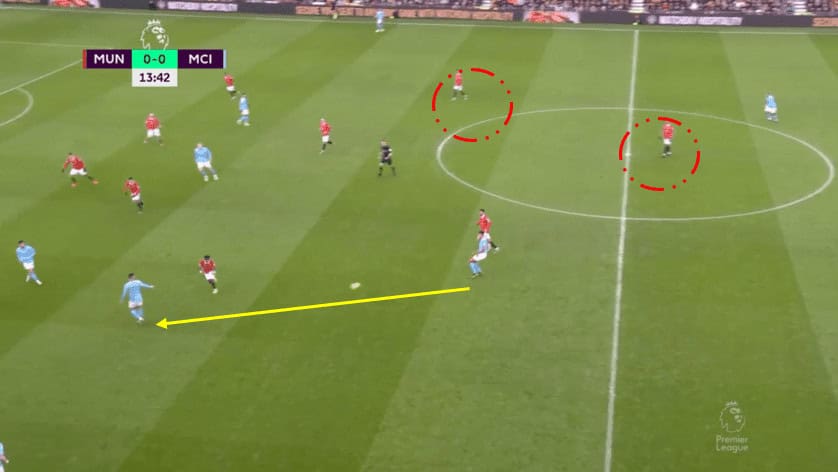
Conclusion
In conclusion, the FA Cup final between Manchester City and Manchester United is set to be a highly anticipated and intense showdown. Both teams have shown their prowess throughout the season, with City aiming for a historic treble and United proving their resurgence under Erik ten Hag’s management.
The analysis highlights the strategies employed by each team in their previous encounters, showcasing the importance of disrupting City’s overloaded centre of the pitch and utilising fast wingers to exploit spaces behind their defensive line. However, injuries have become a significant concern for City, potentially impacting their line-up and overall performance. United’s absence of Antony could also have a significant impact on their attacking options.
Ultimately, the outcome of the final will depend on the ability of both teams to execute their tactical plans and capitalise on scoring opportunities, making it a fascinating clash to determine the boss of Manchester.





Comments